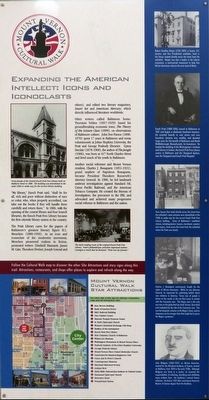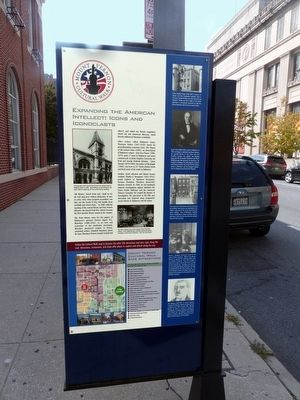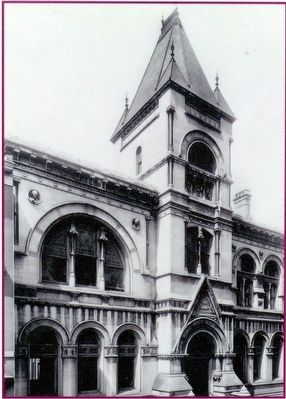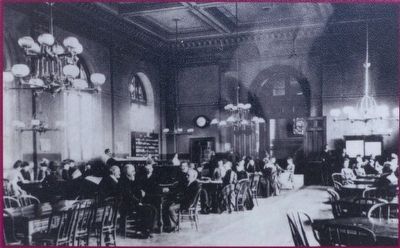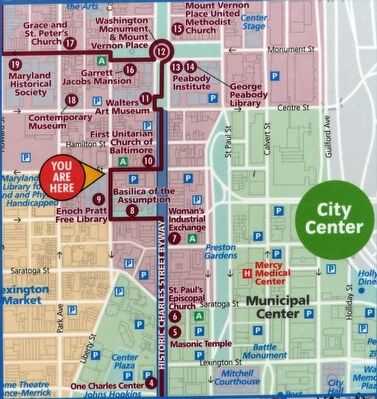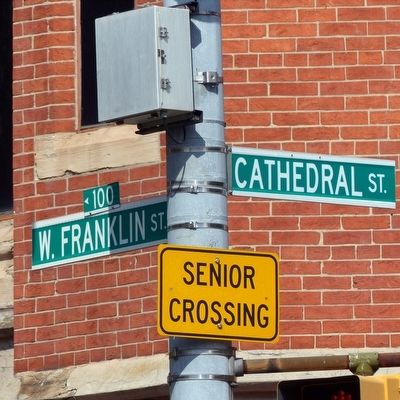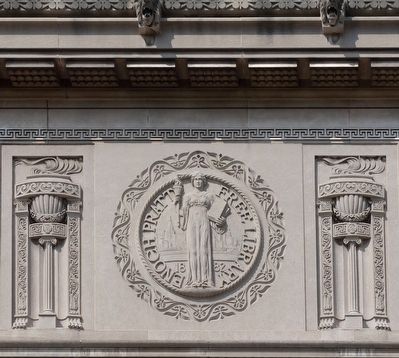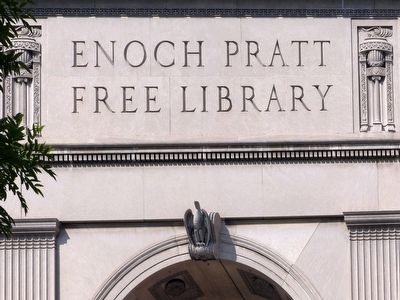Downtown in Baltimore, Maryland — The American Northeast (Mid-Atlantic)
Expanding the American Intellect: Icons and Iconoclasts
Mount Vernon Cultural Walk
Inscription.
“My library,” Enoch Pratt said, “shall be for all, rich and poor without distinction of race or color, who, when properly accredited, can take out the books if they will handle them carefully and return them.” In 1886, with the opening of the central library and four branch libraries, the Enoch Pratt Free Library became the first citywide library system in the country.
The Pratt Library cares for the papers of Baltimore's greatest literary figure H.L. Mencken (1880-1956). As an icon and iconoclast of the modernist movement, Mencken pioneered realism In fiction, promoted writers (Dashiell Hammett, James M. Cain, Theodore Dreiser, Joseph Conrad and others), and edited two literary magazines, Smart Set and American Mercury, which directly influenced literature worldwide.
Other writers called Baltimore home. Thorstein Veblen (1857-1929) based his groundbreaking economic tome, The Theory of the Leisure Class (1899), on observations of Baltimore culture. John Dos Passos (1896-1970) spent 17 years in Baltimore and wrote voluminously at Johns Hopkins University, the Pratt and George Peabody libraries. Upton Sinclair (1878-1968), the author of The Jungle (1906), was born at 417 North Charles Street and lived much of his youth in Baltimore.
Another social reformer and Mount Vernon resident, Charles J. Bonaparte (1851-1921), grand nephew of Napoleon Bonaparte, became President Theodore Roosevelt's Attorney General. In 1906, he led landmark antitrust investigations against Standard Oil, Union Pacific Railroad, and the American Tobacco Company. He created the Bureau of Investigation, the precursor to the FBI, and advocated and achieved many progressive social reforms in Baltimore and the nation.
Topics and series. This historical marker is listed in these topic lists: Arts, Letters, Music • Charity & Public Work • Education. In addition, it is included in the Former U.S. Presidents: #26 Theodore Roosevelt series list. A significant historical year for this entry is 1886.
Location. 39° 17.699′ N, 76° 37.007′ W. Marker is in Baltimore, Maryland. It is in Downtown. Marker is at the intersection of West Franklin Street and Cathedral Street, on the left when traveling west on West Franklin Street. Touch for map. Marker is in this post office area: Baltimore MD 21201, United States of America. Touch for directions.
Other nearby markers. At least 8 other markers are within walking distance of this marker. Enoch Pratt Free Library (within shouting distance of this marker); Basilica of the Assumption of the Blessed Virgin Mary (within shouting distance of this marker); The Basilica of the National Shrine of the Assumption of the Blessed Virgin Mary (about 300 feet away, measured in a direct line); Creating an American Culture: The Golden Age of Baltimore
(about 300 feet away); James Cardinal Gibbons Monument (about 300 feet away); Pope John Paul II Monument (about 300 feet away); The First Unitarian Church of Baltimore (about 300 feet away); a different marker also named The First Unitarian Church of Baltimore (about 300 feet away). Touch for a list and map of all markers in Baltimore.
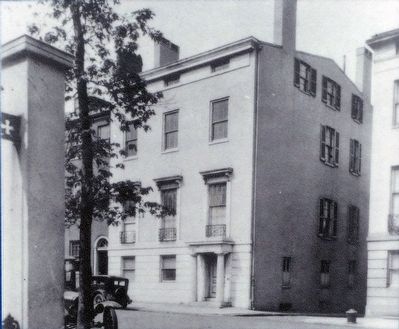
Photographed By Allen C. Browne, September 5, 2015
5. Robert Goodloe Harper House
Robert Goodloe Harper (1765-1825), a lawyer, U.S. Senator,. and Vice Presidential candidate, lived in this house, located directly across the street from the cathedral. Harper was also a leader in the Liberia movement, a controversial movement to help free African Americans colonize the west coast of Africa.Close-up of photo on marker
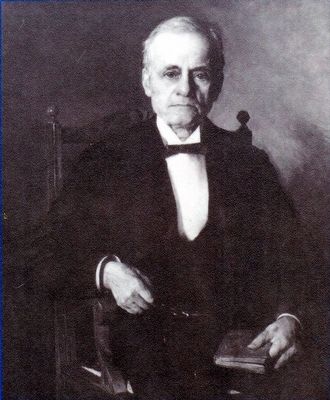
Photographed By Allen C. Browne, September 5, 2015
6. Enoch Pratt
Enoch Pratt (1808-1896) moved to Baltimore in 1831 and began a wholesale hardware business. He invested heavily in coal mines and iron foundries, became very wealthy, and donated large sums for the benefit of Baltimore and North Middleborough, Massachusetts, his hometown. He funded the building of the Workingmen's Institute and Library in Canton, the Enoch Pratt Free Library system in Baltimore and the Sheppard Asylum (Now Sheppard and Enoch Pratt Hospital.) Close-up of photo on marker
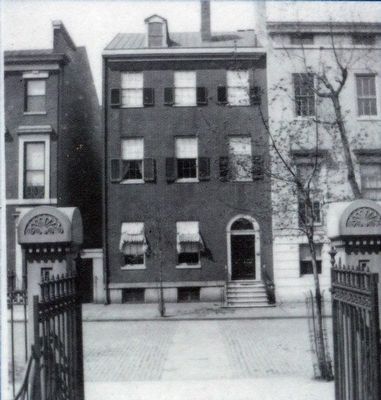
Photographed By Allen C. Browne, September 5, 2015
7. Town Houses
Town houses that stood directly across the street from the cathedral's main entrance were demolished in the 1930s to make way for the current Enoch Pratt Free Library Building. Some of Baltimore's wealthiest citizens, including doctors, lawyers, merchants, senators and mayors, lived across the street from the cathedral where Pratt now stands. Close-up of photo on marker
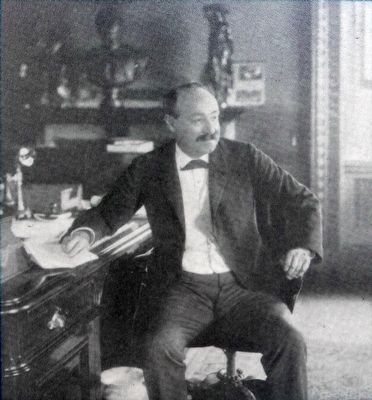
Photographed By Allen C. Browne, September 5, 2015
8. Charles J. Bonaparte
Charles J. Bonaparte continuously fought for the rights of African Americans. While he was Attorney General, he expressed his underlying beliefs about race relations in America, “Every race of people is driven to the woods or die out that comes in contact with the Caucasian race. The Negro race is the only one race on the globe that has lived, thriven, flourished and multiplied by the side of the Caucasian race. This one fact bespeaks volumes in the Negro's favor, and no eloquence can be stronger than that single fad to prove the Negro's greatness.” Close-up of photo on marker
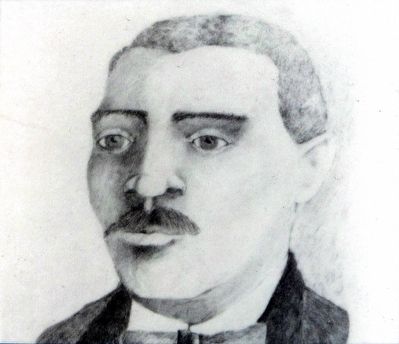
Photographed By Allen C. Browne, September 5, 2015
9. John Widgeon
John Widgeon (1850-1937), an African American, worked for the Maryland Academy of Science, located on Mulberry, from 1870 to the early 1930s. Although Widgeon was hired as a janitor, he assumed the responsibilities of collecting, classifying and exhibiting many artifacts from the Academy's natural history collection. He died in 1937 after receiving an honorary Masters of Science degree from the Academy. Close-up of photo on marker
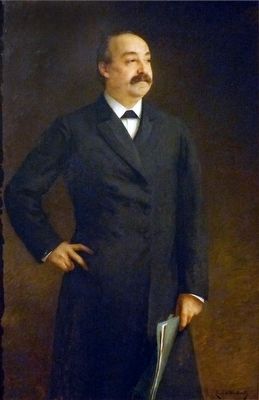
Photographed By Allen C. Browne, September 5, 2015
10. Charles Joseph Bonaparte
This 1906-1909 portrait of Charles Joseph Bonaparte by Cecile de Wentworth hangs in the Maryland Historical Society Museum in Baltimore Maryland.
“Cecile de Wentworth painted this portrait of Charles Joseph Bonaparte between 1906 and 1909 when Charles was Attorney General of the United States under President Theodore Roosevelt. Wentworth was a highly acclaimed American portrait artist who worked primarily in France and painted many of the most prominent men of the early twentieth century, including Presidents Theodore Roosevelt and William Howard Taft.” — Maryland Historical Society
“Cecile de Wentworth painted this portrait of Charles Joseph Bonaparte between 1906 and 1909 when Charles was Attorney General of the United States under President Theodore Roosevelt. Wentworth was a highly acclaimed American portrait artist who worked primarily in France and painted many of the most prominent men of the early twentieth century, including Presidents Theodore Roosevelt and William Howard Taft.” — Maryland Historical Society
Credits. This page was last revised on April 17, 2020. It was originally submitted on September 7, 2015, by Allen C. Browne of Silver Spring, Maryland. This page has been viewed 607 times since then and 12 times this year. Photos: 1, 2, 3, 4, 5, 6, 7, 8, 9, 10, 11, 12, 13, 14. submitted on September 7, 2015, by Allen C. Browne of Silver Spring, Maryland. • Bill Pfingsten was the editor who published this page.
